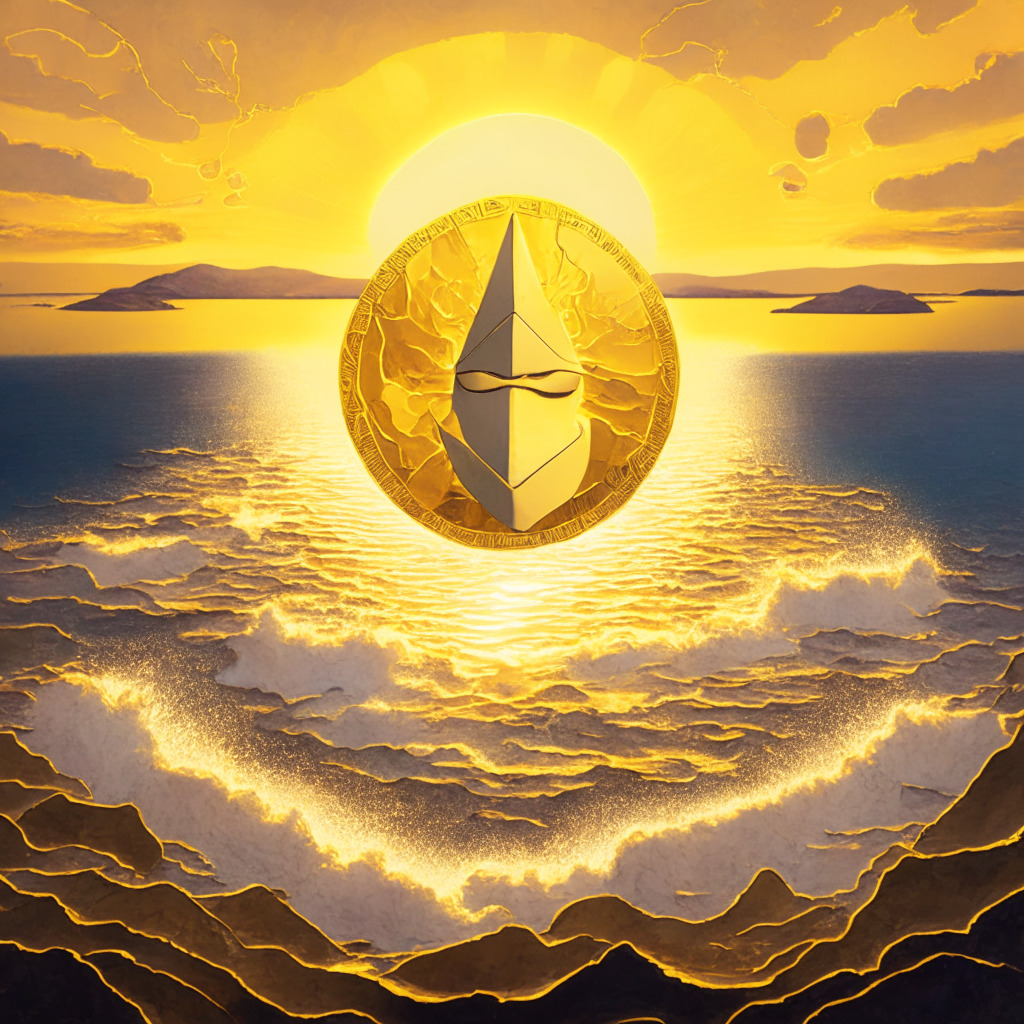Stablecoin issuer Circle has introduced a new version of its euro-backed stablecoin, EURC, now available on the Stellar network. This innovation offers users the ability to handle business via blockchain networks in local currencies. However, converting blockchain transactions into local currencies remains complicated, highlighting the integration challenges that the blockchain community faces.
Search Results for: EU
Kraken’s Expansion in Europe: Spearheading the Crypto Revolution with Key Regulatory Approvals
Crypto exchange Kraken has secured regulatory approvals in Spain and Ireland, furthering its expansion plans in Europe. With a Virtual Asset Service Provider license and an EU e-money license, Kraken will provide digital asset exchange and custodial wallet services.Investment into regulatory framework positions Europe as a promising arena for crypto growth.
Unveiling France’s AI Ambitions: Iliad’s $106m Investment and the Future of European AI
French telecom firm Iliad is investing around $106 million USD in the local artificial intelligence (AI) sector, creating a laboratory for cutting-edge AI research in Paris. The lab will design general AI while possibly making use of Europe’s ‘most powerful cloud-native Ai supercomputer’ created by NVIDIA.
Navigating the Pros and Cons of a Prospective ‘Digital Euro’
The European Central Bank (ECB) discusses its ongoing development of a Central Bank Digital Currency (CBDC) – a digital Euro. The CBDC aims to offer a user-friendly, cost-free alternative to physical cash. Privacy protection, while preventing illegal activities, is emphasized as a fundamental aspect. However, potential creation and acceptance issues raise concerns, and the decision to move forward wouldn’t be decided until later in October.
Arbitrum’s Swift DAO Maneuver: A Power Leap or a Fall into Uncertainty?
The Arbitrum Foundation recently transferred unclaimed tokens worth $56 million into their network’s decentralized autonomous organization (DAO) treasury. While offering new governance possibilities, this move also carries risks and obligations for token holders, speaks volumes about the future for Arbitrum’s users, and poses questions about the speed of tokenizing and redistributing actions within just six months of their DAO launch.
Ethereum Co-founder Buterin’s Big Money Moves: Strategizing or Cash-Out?
“Ethereum’s co-founder, Vitalik Buterin, has reportedly been moving large amounts of ETH to various exchanges. Total transfers in September reach $3.94 million worth of ETH. Despite prices falling, Ether’s trading volume noticeably increases, while Ethereum’s gas usage sees an 8-month low.”
Massive Ethereum Movements: Buterin’s Wallet Activity Sparks Market Speculation
“A series of large Ethereum transactions linked to Vitalik Buterin have been detected, including a 400 ETH transfer to Coinbase. These deposits, ranging over 10 days and amounting to nearly $3.94 million, have sparked speculation about a potential sell-off and its impact on the ETH price.”
Ethereum’s Race for $1,800: Anticipating the Impact of Wall Street Memes Presale
“Ethereum teeters just under the $1,800 mark with the Wall Street Memes presale closing soon. Despite a marginal dip, Ethereum remains the second-ranked cryptocurrency with a market cap of $190 billion. However, the cryptocurrency landscape is volatile and investors should tread with caution.”
Unification or Disruption: A In-Depth Overview of Bitcoin and Ethereum’s Market Stability
“The cryptocurrency giants, Bitcoin and Ethereum, experience minor fluctuations around 1%, trading around $26,500 and $1,600 respectively. This stability, combined with indecisive sentiments from the Fear & Greed Index, contribute to a neutral trading bias in the crypto market, inciting expectation of a breakout.”
CoinShares Boldly Enters US Market despite Regulatory Tumult: A Risky Gamble or Calculated Maneuver?
CoinShares, a popular crypto asset manager, is expanding its market to the US, focusing on cryptocurrency investors with private investment products. Despite possible legal and regulatory challenges, CoinShares is optimistic about navigating the US crypto climate. Its new venture offers a hedge against interest rate-driven volatility in the crypto market.
Coinbase’s Unpursued Acquisition of FTX Europe: The Impact on Crypto Derivatives Trading
Coinbase reportedly aimed to acquire bankrupt FTX Europe to expand its overseas derivatives business but ultimately pulled out. The sale of FTX Europe illustrates the high stakes in the crypto sphere, and the growth and risks associated with derivatives trading.
The Baffling Surge in Ethereum Gas Fees: Binance’s Role and the Crypto Community’s Reactions
The Ethereum network recently experienced a drastic surge in gas prices due to 140,000 transactions directed towards a Binance wallet, leading to extensive costs for users. This resulted in the Ethereum network momentarily being the largest gas user and Binance losing around 530 ETH ($840,000) in gas fees.
Navigating the Storm: EU’s MiCA and the Future of Stablecoins in Europe
“The European Union’s upcoming Markets in Crypto Assets (MiCA) regulation has raised concerns about the potential delisting of all stablecoins in Europe by June 30. MiCA aims to streamline processes and enhance oversight. However, its provisions concerning stablecoins are causing apprehension, especially as they seem to contradict the aspirations of many issuers for decentralization.”
Spot Ethereum ETFs: A Pending Revolution or a Regulatory Nightmare?
The U.S. SEC has initiated a review of two applications for spot Ethereum ETFs from asset managers ARK Invest and VanEck. The applications propose pegging the price of Ether against a reference rate and do not guarantee approval. The SEC has expressed preference for futures-based ETFs for better investor protections. However, regulatory challenges and concerns over market manipulation and asset volatility persist. Despite such hurdles, Spot Ethereum ETFs could potentially boost liquidity and interest in the Ethereum ecosystem.
Investigating OpenAI: Balancing Technological Innovation and European Data Privacy Laws
Poland’s data protection watchdog is investigating OpenAI’s ChatGPT following a complaint accusing the firm of “unlawful, unreliable” data handling. The case surfaces significant matters about personal data protection and OpenAI’s compliance with GDPR, reflecting a broader concern about maintaining a balance between technological innovation and privacy.
China’s Capital Flight: The Potential Bitcoin Boom and the Changing Ethereum Landscape
“In the wake of China’s significant capital flight and a weakening Yuan, the Bitcoin market may see a surge as investors search for alternatives to the feeble domestic market. Despite China’s strict capital controls, crypto may emerge as a lucrative option. However, prevailing uncertainties about the present impact of capital flight on Bitcoin, compared to 2017, remain. Industry changes in the Ethereum universe with the sunsetting of toolkits, Ganache and Truffle, also reflect this blockchain uncertainty.”
From Ethereum’s Nostalgia to MetaMask Snaps: A New Dawn for Developers
Ethereum is witnessing the end of an era with Truffle and Ganache’s sunsetting. However, a new dawn lies ahead with MetaMask Snaps. These changes reflect Ethereum’s ability to evolve and adjust to new opportunities and challenges while promising an exciting future for developers.
Galaxy Digital’s European Expansion: Pros, Cons and the Main Conflict Amid Regulatory Differences
Digital asset services firm, Galaxy Digital has appointed Leon Marshall as its inaugural European Chief Executive, signaling a stride towards global expansion. This venture showcases the firm’s determination to extend its territory despite challenging market trends, spurred by advancements in European digital asset regulation – a factor that’s presenting Europe as a promising crypto hub.
Ethereum’s Uptick Dilemma: Past Expectations Vs. Future Pivots
Despite witnessing a 36% year-to-date price increase in 2023, Ethereum’s price lags significantly behind Bitcoin’s, sparking concern among investors. Even protocol upgrades and the shift to Proof-of-Stake consensus couldn’t sustain Ethereum’s price rise. However, the proposed Ether ETF by ARK Invest and 21Shares, along with Canto’s migration to Ethereum’s layer-2, indicate potential catalysts for recovery.
Unleashing the Potential and Pitfalls of Chainlink’s Entry into Ethereum Layer 2
Chainlink’s entry into Ethereum layer 2, Arbitrum, will facilitate cross-chain DApp development, aiding high-throughput, cost-efficient scaling. The addition of Chainlink’s Cross-Chain Interoperability Protocol (CCIP) on Arbitrum One should unlock various use cases like cross-chain tokenization and blockchain gaming.
Binance’s Plan to Delist Stablecoins in Europe: A Critical Look at Regulatory Compliance and Market Impact
“Binance, a key cryptocurrency exchange, plans to delist all stablecoins for the European market by June 2024, in adherence to the Markets in Crypto Assets (MiCA) law. This move, expected to impact significantly on Europe’s market, reflects the potential disruptions regulatory changes can cause. Meanwhile, the U.S. resists implementing a Central Bank Digital Currency (CBDC), despite other countries’ pursuits of national digital currency.”
Binance’s Ethereum Gas Spend Spree: A Technical Glitch or Evidence of Underlying Inefficiencies?
Binance reportedly spent an astonishing 530 Ether on gas fees in a day due to unexpected spikes in Ethereum network gas prices. This large expenditure, linked to the “Binance 14” wallet, provoked reactions and led to questions about the trading platform’s technology and coin management capabilities.
Ethereum’s Recent Price Dip: A Buying Opportunity or a Shift towards Meme Tokens?
Despite a recent 1% drop in price, market indicators suggest that Ethereum (ETH) is ‘oversold’, signalling a potential buying opportunity. ETH’s price could surge following the anticipated launch of the Holesky testnet on September 28, with strong fundamentals indicating a year-end price of $1,800.
Navigating Malta’s Shifting Crypto Policies: Harmonizing with EU’s MiCA Regulations or Stunting Innovation?
“Malta is reshaping its regulatory landscape for cryptocurrency firms to align with the incoming pan-European Markets in Crypto Assets (MiCA) regulations, impacting businesses from exchanges to portfolio managers. This move indicates Malta’s commitment to global standards and ensures a seamless shift for local Virtual Financial Assets (VFA) Service Providers.”
Undervalued Ether? Evaluating Ethereum’s True Value in Light of Layer 2 Adoption
“According to RRx, Ether, the cryptocurrency of the Ethereum blockchain, is trading at a 27% discount to its intrinsic value. This valuation is based on a modified Metcalfe law model, considering both Ethereum’s mainnet active users and the usership of its layer 2 scaling networks.”
Ethereum’s Holesky Testnet Launch Misfires: A Hiccup or Long-Term Concern?
Ethereum’s anticipated test network, Holesky, faced a launch setback due to a misconfiguration, resulting in a two-week delay. Despite being intended to address Ethereum’s scaling issues and allow for increased validators, the event highlighted vulnerabilities. However, the existing Goerli testnet remains functional, supporting continued application testing. This incident does not affect Ethereum’s subsequent hard fork, Dencun.
Ethereum’s Prospects Amid Testnet Troubles & The Rise of Non-Traditional Crypto Assets
“Ethereum’s recent trading volume exceeded $2.6 billion, boosting its price over the $1,600 benchmark. Despite a hiccup in the Holesky testnet launch due to data entry errors, Ethereum’s mainnet remains unaffected emphasizing the need for testnets in improving validation and staking processes.”
Voir Dire Controversy in the Blockchain World: Neutrality vs Personal Privacy in High-Profile Cases
“The dialogue between the U.S. Department of Justice and FTX founder, Sam Bankman-Fried, centers around jury selection for his case. Prosecutors argue against questions probing potential jurors for connections to FTX, knowledge about ADHD, and sentiments towards effective altruism, believing them to be intrusive and potentially manipulative. The debate underscores the delicate balance of probing for jury neutrality and maintaining personal privacy.”
Ethereum’s Holseky: Innovation Towards Scalability or a Step Towards Centralization?
The Ethereum blockchain is introducing Holesky, the largest test network, set to resolve scalability issues before projects go live. Despite its high potential and efforts in scaling and energy use, concerns remain about Ethereum’s centralized nature and financial barriers for individual validators.
Ethereum Protocol Witnesses Impressive Surge: What this Means for Ether’s Future
The Ethereum network recently witnessed an impressive surge in daily active addresses, hitting 1.088 million. This was significantly higher than the usual 300,000-450,000 range. This spike could be the start of a robust on-chain activity trend and could provide a price boost for Ethereum in the future. However, factors like SEC regulations and ETF approvals will influence its course.
Ethereum Market Dynamics: Potential Climb vs Increasingly Uncertain Terrain
“The Ethereum market exhibits dynamism, with ETH showing resilience after a drop and subsequent 6% rebound. Despite macroeconomic factors possibly boosting cryptocurrencies, concerns over high network fees, regulatory uncertainties and potential U.S. indictment of popular crypto exchange Binance, persist.”
Ethereum’s Holesky vs BitGo’s Bitcoin-Only Trust: Innovations Shaping Blockchain’s Future
Ethereum’s new testnet ‘Holešky’ aims to support staking, infrastructure and protocol development. Its launch, with 1.6 billion ETH available for validators, signals a significant evolution in the blockchain landscape. This network is designed to ease the testing needs of broader Ethereum’s technological advancements. Despite its potential, the success of Holešky isn’t guaranteed due to unpredictable blockchain challenges.































